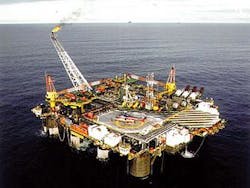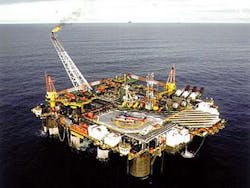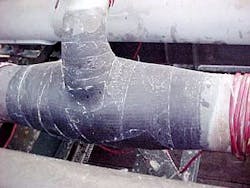Composite materials have been used on Amerada Hess Ltd.'s floating production platform AH001 (Fig. 1) to repair a high pressure, high temperature carbon-steel gas compression line. The platform is on the Ivanhoe field in the UK North Sea.
The line had suffered severe localized wall thinning from external corrosion. A welded repair was not an option because the plant was live; complex geometries made a clamp impractical, according to composite supplier FD Alliance (FDA), a joint venture of DML Ltd. and Furmanite International Ltd.
Amerada Hess said a repair option was needed that would restore structural integrity of the damaged pipe for its expected 5-7 year lifespan. Composites could deal with the awkward geometry of the 8-in. to 4-in. reducing tee.
The gas line operates at 124° C. and 80 barg, which made the repair have to be cured at more than 20° C. above this temperature.
The corrosion damage was fully assessed and the main area of corrosion identified at the 6 o'clock position on the 8-in. pipe, directly below the 4-in. branch (Fig. 2).
Production ongoing
Because no hotwork was required for the repair, production was able to continue with the gas flow diverted to a parallel line. For safety reasons, the damaged line was depressurized before the critical preparation stages of the repair.
Surface preparation is usually carried out by use of grit-blasting, requiring a finish of SA 2.5 (75 μm) for optimum bonding. For this repair, the required surface finish was achieved with wet quill blasting.
A fiberglass tie-coat was then applied, providing a high-quality interface between the pipe's surface and electrical insulation to avoid the possibility of galvanic reaction.
With these preparations in place, the resin-impregnated carbon fiber was applied. The resin matrix is precalculated and quality assessment checks were carried out at every stage of application.
Layers of composites were built up according to a specific design thickness, in this case 16 mm, achieving multi-axial strength. For the purposes of this project, the strength and stiffness derived from a composite repair (up to ten times the strength and twice the stiffness of steel) was a key benefit because the line operates at such high pressure.
Finally, a sacrificial peel ply layer was applied to remove excess resin and provide a surface finish ready to accept paint or any other finish that may be required.
Fig. 3 shows the various components of the composite repair.
For this specific project, the high operating temperatures required a specialist curing technique that actually used the pipe's heat to aid the cure.
To achieve the specified post-cure temperature, trace heating was applied to the pipe as it was brought back to full functionality. As the pipe began to re-pressurize and heat to operating temperature, the cure temperature remained constant at >20° C. above the pipe operating temperature, eventually achieving the required 144° C.
AH001 was able to remain at full production, some 17,000 b/d, during the period of the repair.





